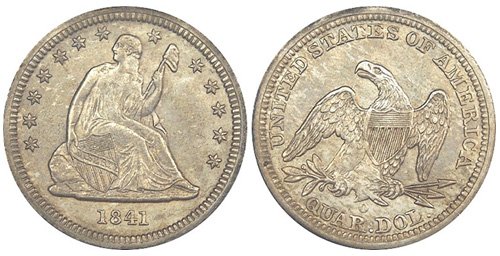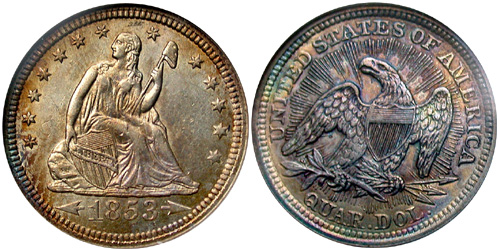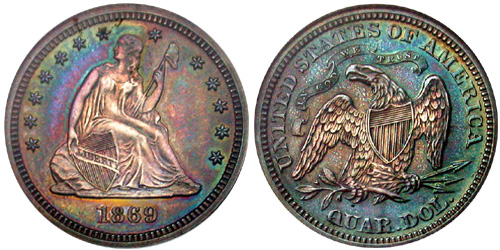Guide to U.S. Seated Liberty Quarters
The Seated Liberty Quarter represented the face of the denomination for much of the 19th century, with pieces struck from 1838 until 1891. The same basic obverse design had been introduced for the half dime and dime in 1837. The design would later be adopted for the half dollar in 1839 and silver dollar in 1840. Similar to these other denominations, the quarter would see numerous modifications to the design and specifications, resulting in a multitude of subtypes. Mintage figures would vary widely during the course of the series ranging from the low thousands to the millions.

The Seated Liberty design was an old concept based on Britannia, who had been featured on British coins. Artist Thomas Sully made a number of sketches, which Assistant Engraver Christian Gobrecht would modify to be suitable for coinage. The original obverse design features an image of Liberty seated on a rock, holding a pole in her hand with a Phrygian cap on top of it. She is looking over her right shoulder and her hand rests upon a union shield with the inscription LIBERTY. The date appears below with thirteen stars surrounding.
The reverse design features an eagle with its wings outstretched and a shield at its breast. The eagle grasps an olive branch and bundle of arrows within its talons. The appearance is similar to the eagle from the previous design by John Reich, but for the present series the eagle has a shorter neck and body with fuller wings. The inscription UNITED STATES OF AMERICA appears above with the denomination written as “QUAR. DOL.” below.
During the first few years after the introduction of the series in 1838, it appeared that the design process had not yet finished, as the relief, sharpness, and execution were still being refined. In 1840, this resulted in the addition of drapery between Liberty’s elbow and knee, creating the second type of the series.

The next design change would come as a result of the Coinage Act of February 21, 1853, which lowered the weight of all silver denominations with the exception of the silver dollar. Congress had mandated the change in an attempt to prevent the widespread hoarding and melting that had arisen due to rising silver prices. To denote the specification change of the quarter, two arrows were placed at each side of the date on the obverse and rays were added around the eagle on the reverse.
The arrows and rays appeared together for only a single year in 1853. For the following two years in 1854 and 1855, the arrows remained at the date, while the rays removed. From 1856 onward, the arrows were removed, although the lower weight standard continued within use.

The next change occurred on the reverse design in 1866, a year after the conclusion of the American Civil War. The motto IN GOD WE TRUST was placed on a scroll above the eagle on the reverse. This motto had first appeared on the Two Cent Piece in 1864, and the following year Congress passed legislation requiring the motto on all circulating denominations large enough to accommodate it.
In 1873, arrows once again appeared to each side of the date on the obverse. This time, it was to indicate a slight increase in weight. The arrows were removed in 1875 and the coins continued to be struck with the increased weight. This would represent the final design modification until the series concluded in 1891, an amazing 53 years after the series had been introduced.

